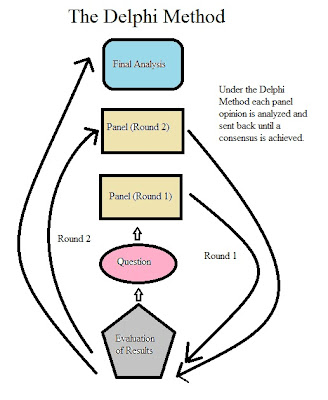Projecting markets can be difficult for executives
who want concrete answers to the potential decisions they are about to make.
One of the strong signs of leadership is the ability to deal with ambiguous
information. This means that decision makers may not have all of the
information they need to make appropriate decisions. Each decision leads to the
possibility of failure with significant financial costs. The use of statistical
methods can be an enhancement to the decision making process through lowering levels
of uncertainty. However, statistics alone can cause mistakes and are not
substitutes for good judgment. Using multiple statistical analyses to make
expensive projection calls can lower decision errors and lead to stronger
choices that improve market choices.
The
Delphi Method:
The Delphi Method was developed by Olaf Helmer while
at the Rand Corporation. In the method participants answer questions about
predictions, products, or services while not being able to interact with each
other. Afterward the results are tabulated and then put within a quartile
system to supply to experts. The experts provide their opinions based upon new
information and those that fall into the outlining quartiles need to justify
their answers. Projections often use only expert opinions while product research may use customer opinions. The answers are then provided back to the original participants
who also justify their answers. Each subsequent round creates additional
consensus on opinions until there is a cluster around a single (or few opinions)
that can be used to project markets.

The advantage of the Delphi Method is that larger
bodies of experts are likely to be more accurate than decisions made by individuals.
As each person continually adjusts their answers through repeated evaluation
the entire process becomes more accurate. Eventually there will be a
predominant opinion that can be used in evaluation and forecasting market
trends.
Imagine for a moment that you are an executive and
you need to make a decision about an expensive investment. However, you are
unsure if the environment will be right for this investment to pay off over the
next five years. To create more clarity in your thinking you poll a number of
experts within the city. They respond but their answers are scattered enough as
to make a prediction both risky and unlikely. You analyze the data and ask the
outliers (people with widely varying opinions) to justify their positions. As
you keep running this process over and over the responses will regress to a
more focused answer that can be used to make decisions.
Cross-Impact
Analysis:
The cross-impact analysis uses available data from
the past to make predictions about the future. There is an assumption that past
events influence future events. Typically a group of experts study correlations
between events and present these within a matrix. The matrix then shows the
probability from 0-1 of a particular event occurring.
We can use an example of the probability that gas
prices will rise if either of two events occur. The simplified example would
not include all of the potential factors that would be included in a true
analysis but does highlight how the process works.
Events: Probability of Event
Given Event Event X and Event Y
X:Plant Shuts Down ---- .2
Y:Trucker Strike .3 ---
This simplified chart is stating that if a plant
shuts down there is a 20% chance gas prices will raise. If there is a trucker
union strikes there is a 30% chance that gas prices will raise. The example
above would not be considered accurate as there are many more events that can
be applied to a potential situation. It is used as an illustration only. An
actual analysis of would also include all the potential factors, the chances of
certain events occurring, and the potential outcomes when those events do occur.
Such an analysis would have factor upon factor all connected together into a
long probability string to predict future events. It is beneficial to put it in a chart or graph
form because it can be hard for people to keep these concepts organized in
their head.
The cross-impact analysis was adopted by the
government and business community in the early 1970’s. There are various forms of this
analysis using different types of formulas and methods of denoting probability.
Some models might simply use a negative or positive sign to denote
opportunities. Other methods might consider “enhancing” and “detracting”
factors to particular events.
This analysis is based on game theory. As each
opponent picks a certain avenue to gain competitive advantage there are
resulting probabilities for the next choice of actions. Each action creates
more probabilities. The advantage in businesses is that they can both lead
their opponent’s choices as well as pick better responses once the opponent has
made choices. The end goal is to increase probabilities of success while
reducing the probabilities of failure. “Check
mate” occurs when all of your opponent’s next choices result in their loss
making the next move nearly useless. Your opponent will either end the game or
pick from increasingly bad choices.
In the world of business, organizations attempt to
predict potential advantages and detractors in order to create proper strategy.
They conduct an environmental analysis to understand all of these potential
possibilities and then use a cross-impact analysis to represent and track these
strategic choices. The key is to create market advantages that result in higher
levels of revenue and market share. The winner is that organization that makes
choices that overcome market challenges and has the highest level of sustainable growth.
As you can see when the organization wins, employees win, the executive wins,
and the shareholders win.
Regression
Analysis:
A regression analysis attempts to find the strength
of relationships between independent and dependent variables. If there are a
number of independent variables it is possible to express a regression analysis
in a formula such as the following:
The regression analysis is often used for modeling
and predicting particular relationships by analyzing how the dependent variable
is influenced when one of the independent variables changes. This allows researchers
to see if a particular change shows a relationship between two elements. For
example, if one of the independent variables is changed and this results in a
dependent variable change then we have a level of influence. Moving through
each of the independent variables will allow for statistical measurements showing
how each factor changes and adjusts the dependent variable.
It must be remembered that the regression analysis
does not prove that one variable causes another variable. It can only show that
there is an association between the two variables and that one has an impact on
the other. Truly understanding the causal relationship would require the adjustment
of inputs that recreate events within a lab or similar type of experimental setting. Some researchers become confused between causation and correlation…even
though there is an important distinction.
The regression analysis is a systematic method of
understanding that can be used in business to understand influences of varying factors.
For example, if a product is purchased more often because it is seen as red and
therefore noticed by customers more often an experiment could be conducted to
determine how these factors are associated. Perhaps it is the price in addition
to the red color? This would require an evaluation of the various factors
through the use of a regression analysis.
The regression analysis first appeared in the
literature by Legendre in 1805 as a method of least squares to understand
orbits around the sun (Legendre, 1805). The
term “regression” was later used by Francis Galton to understand how tall
people appear to regress in preceding generations down to the average of human
height. Today the regression analysis is a major statistical method of
understanding and analyzing association of factors in research.
Dalkey, N. &
Helmer, O. (1963). An experimental application of the Delphi Method to the use
of experts. Management Science, 9
(3).
Fitzsimmons, J. & Fitzsimmons, M. (2011). Service
Management: Operations, Strategy, Information Technology (Seventh Edition).
NY: McGraw-Hill.
Heuer, R. & Pherson, R. (2011). Structured analytic techniques for
intelligence analysis. CQ Press. ISBN :978-1608710188



